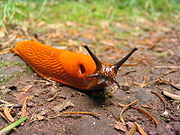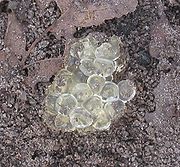
Red Slug
Encyclopedia
The red slug, also known as the chocolate arion or the European red slug, Arion rufus, is a large land slug
, a terrestrial
pulmonate gastropod mollusk in the family Arionidae
, the roundback slugs.
This species is characterised by its (usually) red or brown body and lack of a keel.
(7 in
) in length; although they usually only grow to be 7–10 cm (2.7–3.9 in) long.
Its genus
, Arion, is derived from the name of the legendary Greek
poet
Arion
. Its species name, rufus, is Latin
for red
. Although very often brick-red or brown in coloration, Arion rufus can also be greenish-brown, black, yellow, or orange.


.jpg)
 Perhaps the red slug's most noticeable feature is the placement of its pneumostome
Perhaps the red slug's most noticeable feature is the placement of its pneumostome
just before the mid-point of its mantle
. Like all slugs, the red slug moves relatively slowly, using the muscular contractions of the underside of its foot
, which is mostly red with stripes.
The red slug, like all other slugs, uses two pairs of tentacle
s to sense
its environment. The darkly-coloured upper pair, called optical tentacles, is used to sense
light
. The lower pair provide the red slug's sense of smell. Both pairs can retract and extend themselves to avoid hazards, and, if lost to an accident or predation, can be regrown.
s, fields, or wood
ed areas near human
activity.
in 1913. And with help from people, it spread to the rest of East Jutland
where it, by itself, spread to:
Germany
,
Poland
,
Sweden
,
Norway
and
Great Britain
Slug
Slug is a common name that is normally applied to any gastropod mollusc that lacks a shell, has a very reduced shell, or has a small internal shell...
, a terrestrial
Terrestrial animal
Terrestrial animals are animals that live predominantly or entirely on land , as compared with aquatic animals, which live predominantly or entirely in the water , or amphibians, which rely on a combination of aquatic and terrestrial habitats...
pulmonate gastropod mollusk in the family Arionidae
Arionidae
Arionidae, common name the "roundback slugs" or "round back slugs" are a taxonomic family of air-breathing land slugs, terrestrial pulmonate gastropod mollusks in the superfamily Arionoidea.- Distribution :...
, the roundback slugs.
This species is characterised by its (usually) red or brown body and lack of a keel.
Description
At most, a full-grown red slug can extend to be approximately 18 cmCentimetre
A centimetre is a unit of length in the metric system, equal to one hundredth of a metre, which is the SI base unit of length. Centi is the SI prefix for a factor of . Hence a centimetre can be written as or — meaning or respectively...
(7 in
Inch
An inch is the name of a unit of length in a number of different systems, including Imperial units, and United States customary units. There are 36 inches in a yard and 12 inches in a foot...
) in length; although they usually only grow to be 7–10 cm (2.7–3.9 in) long.
Its genus
Genus
In biology, a genus is a low-level taxonomic rank used in the biological classification of living and fossil organisms, which is an example of definition by genus and differentia...
, Arion, is derived from the name of the legendary Greek
Greeks
The Greeks, also known as the Hellenes , are a nation and ethnic group native to Greece, Cyprus and neighboring regions. They also form a significant diaspora, with Greek communities established around the world....
poet
Poet
A poet is a person who writes poetry. A poet's work can be literal, meaning that his work is derived from a specific event, or metaphorical, meaning that his work can take on many meanings and forms. Poets have existed since antiquity, in nearly all languages, and have produced works that vary...
Arion
Arion
Arion was a kitharode in ancient Greece, a Dionysiac poet credited with inventing the dithyramb: "As a literary composition for chorus dithyramb was the creation of Arion of Corinth," The islanders of Lesbos claimed him as their native son, but Arion found a patron in Periander, tyrant of Corinth...
. Its species name, rufus, is Latin
Latin
Latin is an Italic language originally spoken in Latium and Ancient Rome. It, along with most European languages, is a descendant of the ancient Proto-Indo-European language. Although it is considered a dead language, a number of scholars and members of the Christian clergy speak it fluently, and...
for red
Red
Red is any of a number of similar colors evoked by light consisting predominantly of the longest wavelengths of light discernible by the human eye, in the wavelength range of roughly 630–740 nm. Longer wavelengths than this are called infrared , and cannot be seen by the naked eye...
. Although very often brick-red or brown in coloration, Arion rufus can also be greenish-brown, black, yellow, or orange.


.jpg)

Pneumostome
The pneumostome is a feature of the external body anatomy of an air-breathing land slug or land snail. It is a part of the respiratory system of gastropods....
just before the mid-point of its mantle
Mantle (mollusc)
The mantle is a significant part of the anatomy of molluscs: it is the dorsal body wall which covers the visceral mass and usually protrudes in the form of flaps well beyond the visceral mass itself.In many, but by no means all, species of molluscs, the epidermis of the mantle secretes...
. Like all slugs, the red slug moves relatively slowly, using the muscular contractions of the underside of its foot
Foot
The foot is an anatomical structure found in many vertebrates. It is the terminal portion of a limb which bears weight and allows locomotion. In many animals with feet, the foot is a separate organ at the terminal part of the leg made up of one or more segments or bones, generally including claws...
, which is mostly red with stripes.
The red slug, like all other slugs, uses two pairs of tentacle
Tentacle
A tentacle or bothrium is one of usually two or more elongated flexible organs present in animals, especially invertebrates. The term may also refer to the hairs of the leaves of some insectivorous plants. Usually, tentacles are used for feeding, feeling and grasping. Anatomically, they work like...
s to sense
Sense
Senses are physiological capacities of organisms that provide inputs for perception. The senses and their operation, classification, and theory are overlapping topics studied by a variety of fields, most notably neuroscience, cognitive psychology , and philosophy of perception...
its environment. The darkly-coloured upper pair, called optical tentacles, is used to sense
Sensor
A sensor is a device that measures a physical quantity and converts it into a signal which can be read by an observer or by an instrument. For example, a mercury-in-glass thermometer converts the measured temperature into expansion and contraction of a liquid which can be read on a calibrated...
light
Light
Light or visible light is electromagnetic radiation that is visible to the human eye, and is responsible for the sense of sight. Visible light has wavelength in a range from about 380 nanometres to about 740 nm, with a frequency range of about 405 THz to 790 THz...
. The lower pair provide the red slug's sense of smell. Both pairs can retract and extend themselves to avoid hazards, and, if lost to an accident or predation, can be regrown.
Habitat
The red slug typically lives in gardenGarden
A garden is a planned space, usually outdoors, set aside for the display, cultivation, and enjoyment of plants and other forms of nature. The garden can incorporate both natural and man-made materials. The most common form today is known as a residential garden, but the term garden has...
s, fields, or wood
Wood
Wood is a hard, fibrous tissue found in many trees. It has been used for hundreds of thousands of years for both fuel and as a construction material. It is an organic material, a natural composite of cellulose fibers embedded in a matrix of lignin which resists compression...
ed areas near human
Human
Humans are the only living species in the Homo genus...
activity.
Distribution
This slug is mostly found in Denmark, where it was a was introduced by some scientists in a forrest near SilkeborgSilkeborg
Silkeborg is a city in central Denmark. Located in Silkeborg municipality in Jutland, the city has a population of 42,724 . The development of Silkeborg as a modern city may be traced to the foundation of the paper mill by Michael Drewsen on the Gudenaa in 1844...
in 1913. And with help from people, it spread to the rest of East Jutland
East Jutland metropolitan area
East Jutland metropolitan area is a geographic term for an area in Jutland, Denmark.The term denotes a functional coherent urban area linked by both infrastructure and labour across municipal boundaries...
where it, by itself, spread to:
Germany
Germany
Germany , officially the Federal Republic of Germany , is a federal parliamentary republic in Europe. The country consists of 16 states while the capital and largest city is Berlin. Germany covers an area of 357,021 km2 and has a largely temperate seasonal climate...
,
Poland
Poland
Poland , officially the Republic of Poland , is a country in Central Europe bordered by Germany to the west; the Czech Republic and Slovakia to the south; Ukraine, Belarus and Lithuania to the east; and the Baltic Sea and Kaliningrad Oblast, a Russian exclave, to the north...
,
Sweden
Sweden
Sweden , officially the Kingdom of Sweden , is a Nordic country on the Scandinavian Peninsula in Northern Europe. Sweden borders with Norway and Finland and is connected to Denmark by a bridge-tunnel across the Öresund....
,
Norway
Norway
Norway , officially the Kingdom of Norway, is a Nordic unitary constitutional monarchy whose territory comprises the western portion of the Scandinavian Peninsula, Jan Mayen, and the Arctic archipelago of Svalbard and Bouvet Island. Norway has a total area of and a population of about 4.9 million...
and
Great Britain
Great Britain
Great Britain or Britain is an island situated to the northwest of Continental Europe. It is the ninth largest island in the world, and the largest European island, as well as the largest of the British Isles...
See also
- The red slug is said by some to be the same species as the black slugBlack slugThe black slug also known as black arion, European black slug, or large black slug, scientific name Arion ater, is a species of large land slug, a terrestrial slug in the family Arionidae, the roundback slugs.-Description:...
, Arion ater. - The Spanish slugSpanish slugThe Spanish slug, scientific name Arion vulgaris, more commonly known in English-speaking countries under the incorrectly applied Latin name, Arion lusitanicus, is a species of air-breathing land slug, a terrestrial pulmonate gastropod mollusk in the family Arionidae, the roundback slugs.This is a...
, Arion vulgaris, is known to interbreed with the black slug and perhaps the red slug. - in a matter of 2 years the red slug ate 75% of the west coast strawberries
External links
- Photographs of red Arion rufus. Retrieved July 1, 2005.
- Photographs of brown Arion rufus. Retrieved July 1, 2005.
- Photograph of brown Arion rufus. Retrieved July 1, 2005.
- Various photographs of Arion rufus. Retrieved July 1, 2005.

